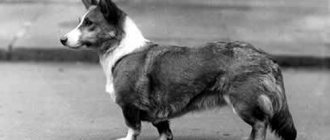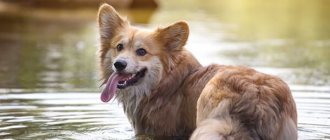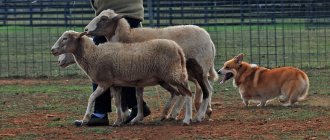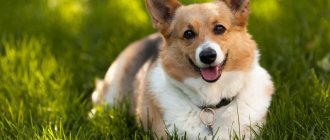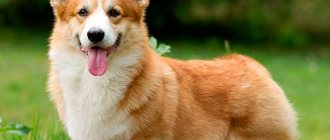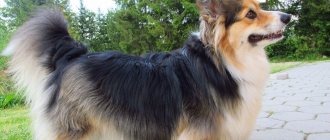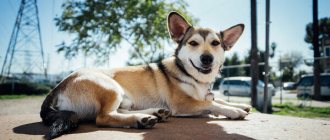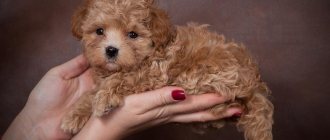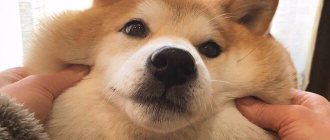| Breed name: | Welsh Corgi Pembroke |
| Breed name in English: | Welsh corgi rembroke |
| Country of origin: | UK (Wales) |
| Type: | A small dog |
| Weight: | 9-12 kilograms |
| Height (height at withers): | 25-30 centimeters |
| Color | White, red, sable |
| Wool length | Short |
| Lifespan: | 12-15 years |
| Character | Smart, loyal, active |
| Number of puppies (average): | 3-8 |
| Price of puppies: | From 1000$ |
Description
The Pembroke Welsh Corgi is a small dog of short stature and strong build. The animal is a wonderful companion. It is very sweet, smart, active and loyal. This breed and the Cardigan Welsh Corgi are often confused, despite their clear differences. Pembrokes have a slightly smaller body, pointed ears and short tails. But the cardigan, on the contrary, has a long tail.
Appearance
— Advertising —
The dog has a strong build, smooth fur and an intelligent facial expression.
An adult Pembroke Welsh Corgi weighs about 9-12 kilograms and is 25-30 centimeters tall.
The head of the individuals is similar to that of a fox. The skull is wide and has a small “cavity” at eye level. The muzzle is conical, the nose is black. The eyes are well set and brown in color. Corgi ears stand straight up. They are long, rounded at the end, and medium in size.
— Advertising —
The neck is quite elongated. The pet's front legs are short and straight, slightly curved. Body of medium length. The hind legs are slightly rounded and powerful.
This breed may or may not have tails. They come in these forms:
- Spiral twisted like a corkscrew.
- Throwed over the back, like a fox.
- In the form of a lowered saber.
Many owners prefer to have their ponytails docked.
The dog's coat is dense and of medium length. There are several possible colors: various shades of red with white spots on the feet, neck and chest; sable coloring (black hairs alternate with red); a color called tricolor (for example, black and red with white spots).
Pros and cons of a dog
Characteristics of advantages:
- This is a playful, active, athletic dog that will always enjoy exercise.
- Loving and faithful.
- Has short coat, easy to care for.
- The dog is polite with strangers, but at the same time is a good watchman.
- The pet gets along well with other pets.
- This is a relatively healthy breed that rarely suffers from hereditary diseases.
Characteristics of minuses:
- In the absence of mental and physical stress, pets will chew and destroy objects in the house.
- The dog has territorial aggression towards animals he does not know.
- The dog sheds heavily in the fall and spring.
- One of the bad habits of some individuals is to constantly bark.
- Animals love to chase everything that moves.
- This is an expensive breed, especially if the puppies are elite.
Key points in training
- There is no need to select any special technique for Corgi dogs, as they are easy to train.
- The pet needs to be taught basic commands (“come to me”, “place”) from the moment it gets into the house.
- You should also call your puppy by name from the very beginning. In this case, by 6-8 months the dog will already be quite obedient, regardless of whether it learns the commands or not.
Read about how to properly train a dog in the article: “Training a puppy: effective methods from dog handlers, learning commands at home.”
Corgis can be trained in agility if the owner wishes. Representatives of this breed can, in principle, be taught almost anything. You don't even need to use tricks and punishments for this. The main rule is that a dog must love and obey its owner. The best format for training is play.
History of the breed
There is a legend that Pembroke Corgis were the horses of Welsh fairies. This is evidenced by the coloring on their back in the shape of a saddle.
The Pembroke Welsh Corgi was first mentioned in records in 920 AD. They are believed to have been brought to Wales by Flemish weavers. From the 14th to the 18th centuries they were used only for grazing livestock. Thanks to their small stature and agility, the dogs bit cattle on the legs and then managed to dodge the blows.
As the name suggests, the Pembroke Welsh Corgi was bred in Wales in the Pembrokeshire region. The Cardigan Welsh Corgi is the older of the two Corgi breeds. Therefore, of course, it was used in breeding the Pembroke species.
The breed was recognized by the English Kennel Club in 1928. Back then, Pembroke and cardigan were considered the same species. Only in 1934 a standard for each type was identified.
The Pembroke's appeal increased when it became a favorite of King George VI and subsequently Queen Elizabeth II. By the 1960s, the Corgi had become one of the most popular pet breeds throughout the world, especially in Britain.
Maintenance and care
The Pembroke Welsh Corgi has a medium length coat with a short undercoat. The breed has a tendency to lose a significant amount of it. This occurs especially intensively in spring and autumn. Regular grooming of your dog is very important. It mainly consists of brushing the coat once or twice a week. During molting, carry out the procedure daily. Brushing should ideally take 10 minutes to completely remove dead hair.
The frequency of bathing will vary depending on what activities your dog participates in. It is recommended to bathe your dog every 6-8 weeks. For the procedure, use warm water and special shampoo.
Groom and trim your pet's nails regularly to prevent furniture scratching. It is recommended to carry out the procedure every 2-3 weeks.
Keep your pet's teeth and gums healthy. To do this, clean them daily or at least a couple of times a week.
This is an active breed that loves to run. Therefore, it is important to give your pet daily exercise to prevent obesity. Too much wasted energy and lack of training can lead to excessive barking and other behavior problems.
Skinny Welsh Corg
If the corgi's pelvic bone is visible, and the fur is matted and dull, then the pet has digestive problems.
Increasing the protein in the food and feeding it four times a day will help your dog gain weight..
Fatty foods can cause diarrhea, so you should not add them to your diet. Cottage cheese, chicken eggs, kefir will be an excellent supplement for an exhausted dog.
With such feeding, after a month the dog should regain its weight.
CAREFULLY!
If this does not happen, you should meet with a veterinarian; perhaps your pet has an illness and the thinness is a consequence.
Nutrition
Feed adult dogs a high-quality food. Follow these guidelines, but take into account the general activity of the animal:
- Weighing 9 kg or more – from 129 to 176 g.
- Weighing 10 kg or more – from 139 to 189 g.
- Weighing 11 kg or more – from 149 to 196 g.
- Weighing 12 kg or more – from 159 to 209 g.
Feed twice a day: the first time in the morning and the second in the evening. Do not overfeed your pet, no matter how much he asks. Excessive amounts of food lead to obesity and shortened lifespan of individuals.
Older Corgis should be fed food that suits their needs at this stage of life. It is important to choose the right food. Below is the approximate amount of necessary substances for an elderly dog:
- Protein from 14 to 21%.
- Fats less than 10%.
- Fiber less than 4%.
- Calcium 0.5-0.8%.
- Phosphorus 0.4-0.7%.
- Sodium 0.2-0.4%.
Obesity in pets
Obesity is a disease caused by low activity in the shepherd dog and improper feeding. The cause may also be hereditary characteristics.
At the first signs of obesity, it is necessary to reconsider the feeding diet . Carbohydrates and fatty meats should be excluded. Add vegetables and fruits, but leave the meat in the same quantities.
After eating the food, when the dog has moved away from the bowl, the bowl must be removed. At the next feeding, reduce the amount of feed.
Even if the dog receives one tablespoon of food and does not touch it, it still should not receive the next portion earlier than usual.
Breeding
Before mating, the health of the individuals is checked. This is especially true for genetic diseases. It is not permissible to breed long-haired, nervous and biting dogs.
Dogs are bred when males are 24 months old and females are 20 months old. Although the first heat in girls occurs at 7-8 months. Females over the age of nine years are not allowed to become pregnant.
The girl is prepared for mating in advance: vaccinations are given, prophylaxis against parasites, the condition of the heart, joints, and thyroid gland is checked.
Before the procedure, the individuals are introduced: they are walked together or left in a room for communication.
The bitch's pregnancy lasts from 2 to 2.5 months. As a result, from 3 to 8 puppies are born. Be sure to ensure that a specialist is present at the birth. Your pet may need a caesarean section.
Puppies
Within the first few days after purchase, take your new friend to the veterinarian. This is necessary to ensure the health of the animal. Visit a specialist periodically for vaccinations, deworming and annual tests.
Pembroke Welsh Corgis need daily exercise to stay in shape. The baby will need more of them than adults. Spend at least 15 minutes a day exercising. Training and education should be carried out by you from a very early age.
Many owners wonder: what is the best way to feed small corgis? Feed your babies special high-quality food. The approximate amount of food depends on body size and age. The scheme is as follows:
- 2 months – from 153 to 161 g.
- 3 months – from 179 to 193 g.
- 4 months – from 191 to 209 g.
- 5 months – from 194 to 213 g.
- 6 months – from 194 to 213 g.
- 8 months – from 157 to 191 g.
- 10 months – from 139 to 147 g.
After your baby reaches 1 year of age, feed him as an adult.
Stick to the following schedule:
- For puppies between 8 and 12 weeks of age, feed food 4 times a day.
- From 3 to 6 months – three times a day.
- From 6 months to 1 year – 2 times a day. Then you can leave eating 2 times a day, or you can reduce it to once.
Photos of the babies are presented below.
Dog character
The pet loves to be close to people. This breed is known to want constant interaction with the entire family. They may suffer from separation anxiety when left alone for long periods of time.
As a companion, the Corgi is protective of its family and will warn of any strangers. Animals need to be socialized at an early age to know how to behave around people they don't know.
Dogs are suitable for children and the elderly. When Corgis become agitated, they may bite their heels in response to play. This is due to their original job of being shepherds.
Pets are known to bark a lot if they are not trained. However, they are easy to train due to their high intelligence. The dog loves to be constantly busy. During training and training, use gentle methods, as the dog does not tolerate roughness.
The dogs get along well with other dogs and pets.
Some Pembrokes love to swim, especially in hot weather. However, if your pet doesn't want to go into the water, never force him. This can frighten the dog and cause him stress.
Advantages
- Corgis are truly suitable for beginner dog owners. They are quite easy to train and do not require special care (with the exception of the Fluffy subspecies). Representatives of this breed settle well into the family, quickly become attached to all its members and do not enter into conflicts with other animals or children.
- These dogs are considered very smart . They easily remember commands, learn and adapt. Corgi understands the mood of the owner from the moment a strong bond is formed between them. This pet can truly fully replace a friend and companion.
- Representatives of the species, in principle, do not conflict. They show their friendliness towards other animals and familiar people. They are wary of strangers, but in most cases this rule does not apply to children. Corgis are loyal, kind and gentle dogs, making them suitable for most people.
- The breed standard states that these dogs have a real sense of humor. They are able to amuse their owners and the people around them.
Education
Pembroke Welsh Corgis are intelligent animals, so training them is not that difficult. Here are some tips you can follow when training:
- Be persistent when training your dog. Like other breeds, Corgis instinctively seek out an "alpha male" or "pack leader." Therefore, you need to show your authority so that the puppy always obeys you.
- Use incentives. Never use harsh methods or force. This attitude will make your puppy fear you rather than respect you. Instead of yelling or intimidating your dog, give him treats for doing the right thing. However, don't overdo it with rewards. Overfeeding individuals leads to obesity.
- Socialize your puppy from an early age. Don't be afraid to introduce him to new situations, people and other animals.
- Be consistent. For example, don't reward your dog both times he gets a trick right and only gets it halfway the second time. This will send mixed signals to your pet. He will not understand what actions are correct.
- The first commands your pet should know are: come, sit, stay, be quiet, no, leave it, place.
Who are Fluffies?
Sometimes purebred parents give birth to puppies with defective coats. Their coat is longer and softer than allowed by the standard. Such puppies are called “fluffy”, they have much less undercoat, which is why the coat quickly gets wet and often tangles. Outwardly, they look very impressive, like soft and fluffy foxes. If you do not plan to participate in breeding work, then fluffy will be an excellent choice. In terms of price, they are usually sold cheaper than their counterparts with coarse hair, and in appearance they are in no way inferior to them. However, you must purchase such a dog from a professional kennel, so that under the guise of a fluffy they don’t accidentally slip you a mongrel.
Diseases
The Pembroke Welsh Corgi is considered a healthy dog. But there are a number of diseases and health conditions that are genetic. This does not mean that your pet will necessarily have such problems. It just needs to be noted that the species is at greater risk of contracting the disease than other breeds. Here is a description of some common genetic problems:
- Heart diseases. Pembrokes are susceptible to a condition called incomplete closure of the heart valve. In this condition, the small valve that passes blood between the two parts of the heart does not close properly. Therefore, too much blood enters the lungs, which leads to fluid accumulation and increased stress on the heart. Main signs: cough, fatigue during exercise, weight loss, shortness of breath and weakness in the hind legs. Contact a specialist immediately.
- Blood clotting disorder. The animal appears healthy until serious injury or surgery occurs. As a result, severe bleeding may occur. Von Willebrand's disease is a bleeding disorder that is common in Pembroke Corgis.
- Problems with the spine. Intervertebral disc disease is a common condition in dogs with long backs and short legs. It occurs when the jelly-like cushion between one or more vertebrae slips or ruptures. This causes the disc to press on the spinal cord. Symptoms of the disease: the dog moves poorly, refuses to climb stairs, has a hunched back, and cries. All this is caused by pain. Contact your veterinarian immediately.
- Dysplasia of the hip and elbow joints. Your pet's hips and elbows are at risk for dysplasia. This is an inherited disease that causes abnormal joint development and leads to arthritis. Stiffness in your Pembroke's elbows or hips can be a problem for him. Symptoms: lameness in the legs, the dog has difficulty standing up. The sooner you treat your pet, the better it will be for his health.
- Eye problems:
- cataract
- progressive retinal atrophy
- persistent pupillary membrane. This occurs when small pieces of tissue that should disappear soon after birth remain attached to the iris.
In addition to hereditary diseases, the animal may be susceptible to common diseases:
- Dental problems.
- Obesity.
- Parasites.
- Infections.
What affects growth?
You can pick up a puppy from the breeder no earlier than 45 days, when the baby has had vaccinations and a metric, which is subsequently exchanged for a pedigree.
The first vaccination is very important, because before it the puppy was treated for worms.
Puppies infected with helminths are highly susceptible to viral and infectious diseases. These animals have difficulty digesting food and experience diarrhea, which interferes with full development.
You need to take some of the puppy’s usual food from the breeder; a sudden change in food can cause stool failure, which will lead to weight loss. The puppy's low weight and diarrhea can slow down weight gain, and rapid growth will make the baby look thin.
A puppy needs adequate nutrition and frequent feedings . So, at the age of four months, the pet should eat 10% of its weight in food.
The food should be divided into four portions. Each serving should be 200 grams of complete food (not dry). If the food is well absorbed, the puppy will quickly gain weight, while remaining active and playful.
NOTE!
If a dog receives natural food, then for development it needs complex vitamins and minerals; they are sold in a veterinary pharmacy and are divided according to the age of the puppies.
Walking and playing will have an excellent effect on the puppy’s health and muscle gain, and a good mood and good sleep after a walk will help the dog grow strong and healthy.
Genetic predisposition also affects weight gain . If the puppy’s ancestors have problems with muscles or bones, then the baby may inherit such features.
Interesting Facts
- Pembroke's personality was described in one article as being a cross between a sea captain and a high school teacher. He enjoys being involved and in charge at the same time.
- In 2012, Orange Country hosted its first Corgi Beach Day. At first it was an exhibition of 15 corgis and their owners. Today, it has become a series of organized events throughout the country. The world record took place in Huntington, California. Information states that more than 1,200 spectators attended the event.
- A Pembroke named Rufus belonged to the editor-in-chief of Amazon.com. At the stage of site promotion, he came to work with the owner every day, walked around the halls, attended meetings and dozed off during them. Later, Rufus became the site's unofficial mascot.
- For over 70 years, corgis have been part of the British family. Queen Elizabeth was the proud owner of more than 30 corgis. The Pembroke Welsh Corgi is her favorite breed.
- The species has a recessive gene called the fluffy gene. It can be in both a bitch and a dog. If the parents have this gene, then the litter may produce one or more puppies with long hair.
- When the dog lays his body on the ground, from behind his butt looks like two chicken wings. This funny position of the dog is called sploot.
